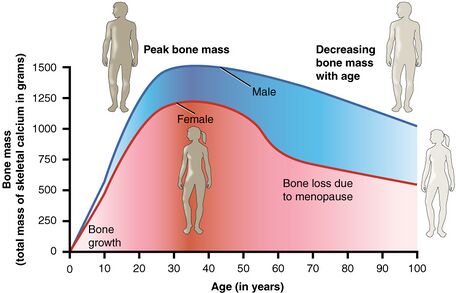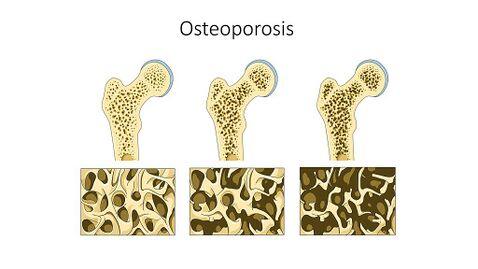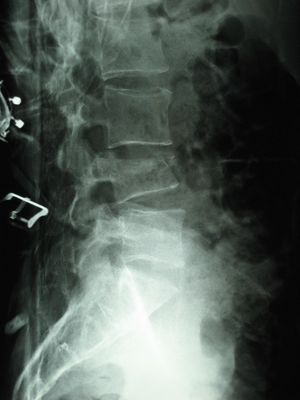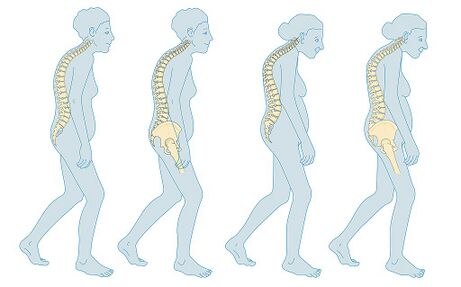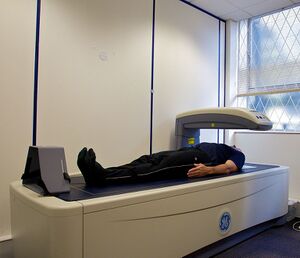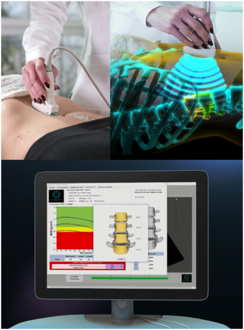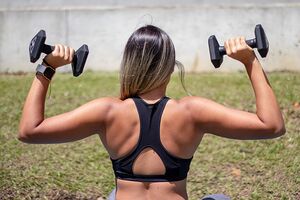Bone Density
Original Editor - Lucinda hampton
Top Contributors - Lucinda hampton, Angeliki Chorti and Kim Jackson
Introduction[edit | edit source]
Bone density is a measure of the amount of minerals (mainly calcium and phosphorous) contained in a certain volume of bone. Bone density changes during life. Bone mineral density (BMD) is set by the amount of bone present in the skeletal structure, with the higher the BMD, the stronger the bones, and vice-versa. BMD greatly influenced by genetic factors (60% to 80% of variance in peak bone mass is attributed to genetic factors[1]) which can be modified by environmental factors and medications (see epigenetics). Usually, BMD accumulates during childhood and reaches a peak at roughly age 25, which is maintained for about 10 years. After age 35, both men and women normally lose 0.3–0.5% of their BMD per year as part of the aging process.[2]
Bones provide the scaffolding that allows our bodies upright to remain upright. Healthy bones are not solid, their interiors being made of a honeycomb structure with tiny holes to keep them light and springy. When bones reduce their mineral density they have much larger holes as well as thin cortical walls, which can increase their risk of fracturing. This is why bone density is important
Bone density measurements are useful in the diagnosis of osteoporosis, to see how well osteoporosis treatments are working, and to predict how likely the bones are to break.[3][4]
Decreased Bone Density[edit | edit source]
Bone density can decreases in a wide variety of condItions and increase risk for conditions such as osteoporosis and osteopenia, which is not as extreme as osteoporosis. Low bone density is a global problem, worldwide, osteoporosis causes more than 8.9 million fractures annually, resulting in an osteoporosis fracture every 3 seconds.[5]Increased risk factors for lower bone density include:
- The bones may lose density as a person continues to age.
- After menopause, in particular, a person becomes susceptible to osteoporosis, a disease that can lead to insufficiency fractures.
- Smoking
- Drinking excessive amounts of alcohol
- Low physical activity
- Poor diet, low in vitamins and calcium
- Medical conditions, for example, rheumatoid arthritis, chronic kidney disease, overactive parathyroid gland or celiac disease, eating disorders
- Excessive soft drink intake
- Low body mass index
- Various medications for example prolonged use of corticosteroids to treat asthma or arthritis, anticonvulsants, aluminum-containing antacids and cancer treatments.
- Multiple myeloma, tumors initially affect the bones and bone marrow of the vertebrae, ribs, skull, pelvis, and femur.[6]
Estrogen and BMD[edit | edit source]
Estrogen is important in maintaining BMD in women. After menopause, when estrogen levels start falling, loss of BMD accelerates. During the first 5–10 years after menopause, women can experience up to 2–4% loss of BMD yearly, resulting in the loss of up to 25–30% of their BMD in these 10 yers. The accelerated bone loss after menopause is a major cause of osteoporosis in women, referred to as postmenopausal osteoporosis[2].
Measuring BMD[edit | edit source]
Bone mineral density can be measured by various methods, with DEXA being the most prevalent in modern clinical practice. Other ways to measure BMD include:
- Single energy x-ray absorptiometry: a single x-ray beam is used to measure bone density at peripheral sites for example the forearm and heel. The area to be tested is wrapped in a tissue-like substance or immersed in water to improve the quality of the results.
- Ultrasound: measurements taken during an ultrasound may provide data on the structural integrity of bone. New ultrasound devices such as quantitative ultrasound (QUS) can estimate bone density of the heel within minutes, providing an automatic print-out of results[7]. An example of this the new device is the Radiofrequency Echographic Multi-Spectrometry (REMS) is a relatively recent technology that performs the analysis of bone quantity and quality through a non-ionizing approach. The ultrasound device known as Echolight was approved by the FDA and doctors in the US are beginning to give it a try. REMS technology ultrasound signals appears to be able to overcome the most common artifacts, for example OA and vertebral fracture of the lumbar spine, which affect the value of BMD by DXA. Will the New Ultrasound Device Replace DEXA Bone Density Testing? [8][9][10]
Medicines for low BMD[edit | edit source]
Osteoporosis medicines can increase bone density and while the increases may appear small this can have a very positive effect on reducing fracture rates. For example, medication can increase bone density in the hip by approx. 1-3% and in the spine by 4-8%, over the first 3-4years of treatment. Medication can reduce spinal fractures by around 30-70% and hip fractures by 30-50% (a positive effect can be seen as early as 6 – 12 months after starting treatment).
Medical management isn't the only way to treat osteoporosis. It is also important to include daily exercise, good nutrition (including adequate amounts of calcium and vitamin D), smoking cessation, and limiting alcohol intake.[11]
Physiotherapy[edit | edit source]
There are many ways to help boost and maintain bone density. For for tips on increasing bone density naturally see the physiotherapy and dietary section in this informative page Osteoporosis and this page in general Mechanical Loading of Bone.
References[edit | edit source]
- ↑ Shlomo Melmed MB ChB, MACP, in Williams Textbook of Endocrinology, 2020 Available:https://www.clinicalkey.com.au/#!/content/book/3-s2.0-B9780323555968000267 (accessed 6.8.2022)
- ↑ 2.0 2.1 Caballero B, Finglas P, Toldrá F. Encyclopedia of food and health. Academic Press; 2015 Aug 26. Available:https://www.sciencedirect.com/referencework/9780123849533/encyclopedia-of-food-and-health (accessed 6.8.2022)
- ↑ NIH Bone Density Available:https://www.cancer.gov/publications/dictionaries/cancer-terms/def/bone-density (accessed 6.8.2022)
- ↑ Medical news today 11 ways to increase bone density naturally Available:https://www.medicalnewstoday.com/articles/325903 (accessed 6.8.2022)
- ↑ Johnell O, Kanis JA. An estimate of the worldwide prevalence and disability associated with osteoporotic fractures. Osteoporosis international. 2006 Dec;17(12):1726-33. Available:https://pubmed.ncbi.nlm.nih.gov/16983459/ (accessed 6.8.2022)
- ↑ Yale medicine Low bone density Available:https://www.yalemedicine.org/conditions/bone-density-test (accessed 6.8.2022)
- ↑ Better Health Bone density testing Available:https://www.betterhealth.vic.gov.au/health/conditionsandtreatments/bone-density-testing (accessed 6.8.2022)
- ↑ Caffarelli, C., Tomai Pitinca, M.D., Al Refaie, A., De Vita, M., Catapano, S. and Gonnelli, S., 2022. Could radiofrequency echographic multispectrometry (REMS) overcome the overestimation in BMD by dual-energy X-ray absorptiometry (DXA) at the lumbar spine?. BMC Musculoskeletal Disorders, 23(1), pp.1-8. Available: https://www.ncbi.nlm.nih.gov/pmc/articles/PMC9118880/ (accessed 6.8.2022)
- ↑ Cortet B, Dennison E, Diez-Perez A, Locquet M, Muratore M, Nogués X, Crespo DO, Quarta E, Brandi ML. Radiofrequency Echographic Multi Spectrometry (REMS) for the diagnosis of osteoporosis in a European multicenter clinical context. Bone. 2021 Feb 1;143:115786. Available:https://www.sciencedirect.com/science/article/pii/S8756328220305743?via%3Dihub (accessed 6.8.2022)
- ↑ Better Bones Will the New Ultrasound Device Replace DEXA Bone Density Testing? Available:https://www.betterbones.com/bone-health-basics/will-the-new-ultrasound-device-replace-dexa-bone-density-testing/ (accessed 6.8.2022)
- ↑ Osteoporosis
